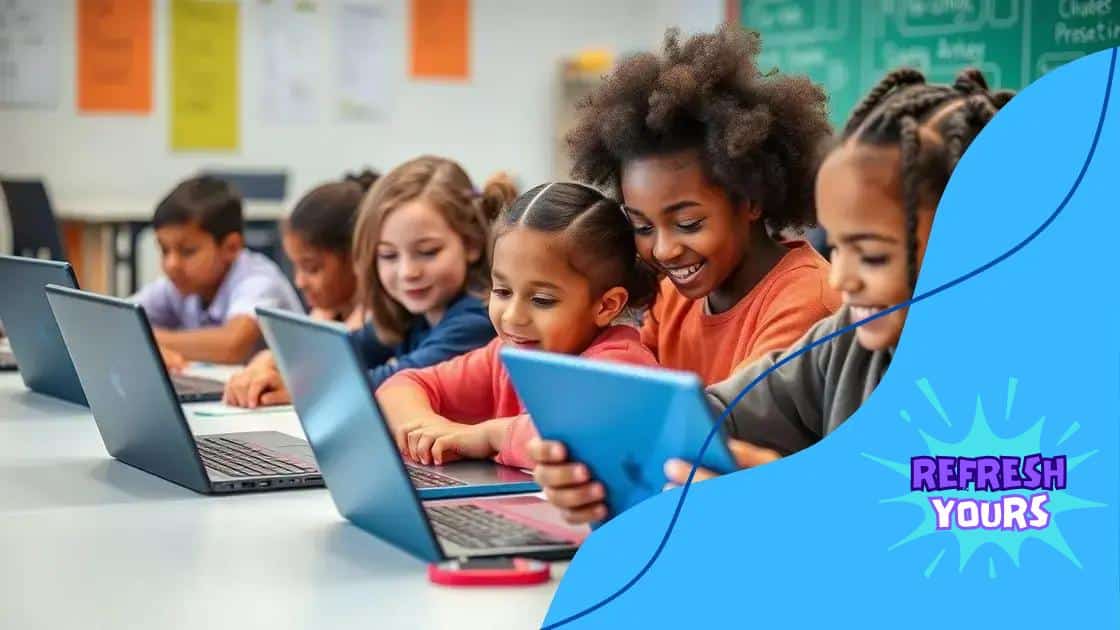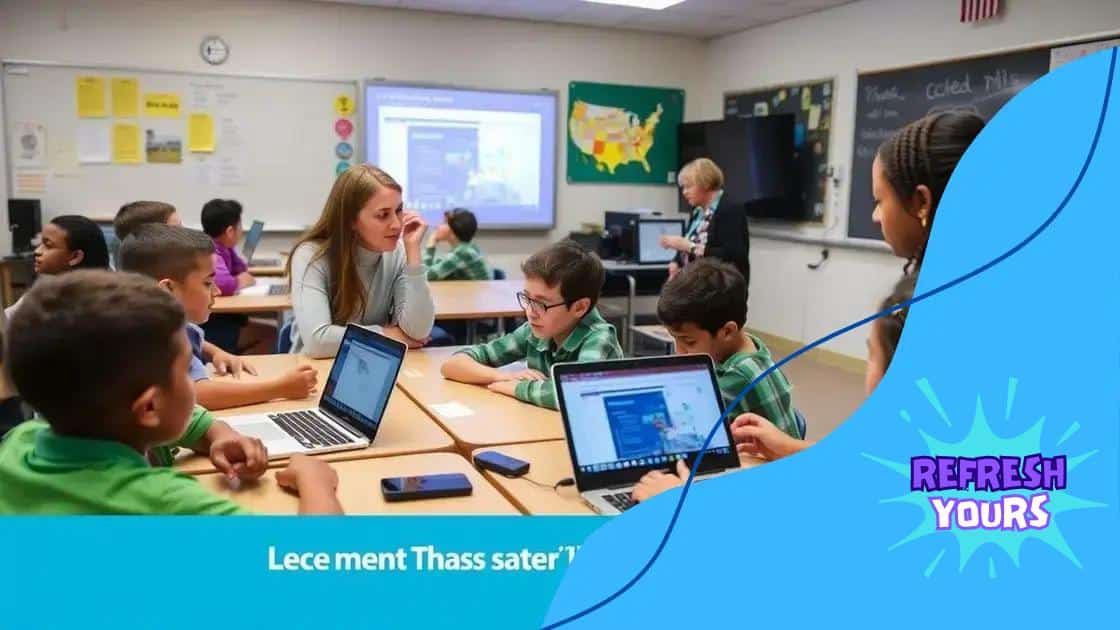The growing importance of coding in K-12 education

The growing importance of coding in K-12 education enables students to acquire essential skills for future job markets, enhances problem-solving abilities, and promotes inclusivity in learning environments.
The growing importance of coding in K-12 education is becoming a vital area of focus for educators and parents alike. Have you considered how learning coding could open doors for your child in the future?
Understanding coding in K-12 education
Understanding coding in K-12 education is essential for preparing students for future careers. This new skill set is not just about learning to program; it’s about solving problems and fostering creativity.
What is Coding?
Coding, or programming, involves writing instructions for computers to follow. In K-12 education, this means teaching students how to communicate with technology and create their own digital projects.
Benefits of Learning Coding
There are numerous benefits to incorporating coding into the curriculum. Some key advantages include:
- Enhancing critical thinking skills
- Encouraging teamwork and collaboration
- Preparing for future job opportunities
- Fostering creativity and innovation
When students learn to code, they develop a greater understanding of how technology works. This knowledge empowers them to be creators rather than just consumers of technology. Moreover, coding can be fun! Many coding programs for kids use games and challenges to keep students engaged.
Schools that adopt coding as part of their standard curriculum often see positive outcomes. Students not only perform better in technology-related subjects but also gain useful skills applicable in many fields. As technology continues to evolve, the need for talented individuals in coding will only increase.
Overall, understanding coding in K-12 education can transform learning experiences. It opens doors to various career paths and equips students with the tools they need to succeed in a digital world.
Benefits of coding for students
The benefits of coding for students are vast and significant. Learning to code equips students with essential skills that go beyond the classroom. It encourages creativity, problem-solving, and critical thinking.
Key Benefits
One of the most important aspects of coding is its ability to enhance logical reasoning. By working through coding challenges, students learn to break problems into smaller, manageable parts. This skill is transferable to many areas in life.
- Promotes Analytical Skills: Coding requires students to analyze problems and develop solutions, sharpening their analytical thinking.
- Fosters Collaboration: Many coding projects are done in teams, helping students learn to work with others towards a common goal.
- Encourages Persistence: Debugging code can be frustrating. However, it teaches students the importance of persistence and resilience.
- Prepares for Future Careers: As the tech industry grows, coding skills become increasingly valuable in various job markets.
Moreover, coding enhances creativity. Students can build games, apps, and websites, allowing them to express themselves in unique ways. This element of creativity makes learning coding enjoyable and engaging.
Coding also serves as a gateway to understanding technology. As technology permeates every aspect of our lives, having foundational knowledge in coding allows students to navigate this digital world with confidence.
In summary, the benefits of coding create better learners and prepare students for the challenges of the future. Engaging with coding not only makes students more competent in technology, but also cultivates essential life skills.
Integrating coding into the curriculum

Integrating coding into the curriculum is becoming essential in today’s educational landscape. Schools recognize that coding skills are important for students’ future success. By incorporating coding into various subjects, educators can create a more engaging and interactive learning experience.
Strategies for Integration
One effective method is to incorporate coding in subjects like mathematics or science. For example, students can use coding to create simulations that help visualize complex concepts. This approach links coding directly to the curriculum, making learning more relevant and practical.
- Project-Based Learning: Students can work on coding projects that align with their subject matter, such as developing a simple app related to their science project.
- Interdisciplinary Lessons: Teachers can combine art and coding by having students create visual projects using programming languages.
- After-School Programs: Implementing coding clubs helps interested students explore coding beyond regular classroom time.
- Professional Development: Investing in training for teachers ensures they feel confident teaching coding concepts.
Integrating coding isn’t just about learning to program; it also helps develop critical thinking and problem-solving abilities. Students gain invaluable skills when they learn how to approach challenges methodically. As students experiment and iterate on their projects, they learn the importance of feedback and revision, valuable lessons in any subject.
In addition to providing valuable skills, integrating coding can enhance student engagement. As learners interact with technology, they are more likely to stay motivated and participate in their education. Motivated students tend to perform better academically, making integration of coding a win-win for both students and educators.
By weaving coding into various subjects, schools can prepare students for a technology-driven world while enhancing their overall learning experience. Students gain a strong foundation in coding that will serve them in many future roles.
Challenges of teaching coding
Teaching coding in schools comes with various challenges that educators must navigate. While integrating coding into the curriculum is essential, it requires careful planning and resources. Identifying these challenges can help in finding effective solutions to make coding education successful.
Lack of Resources
One significant challenge is the lack of resources available for teaching coding. Many schools may not have access to the latest technology or software needed for effective coding instruction. This can create disparities in learning opportunities.
- Limited funding: Financial constraints can prevent schools from purchasing necessary tools and software.
- Insufficient teacher training: Many educators require training to feel confident in teaching coding effectively.
- Outdated equipment: Using old computers can hinder students’ coding experiences.
Moreover, educators often face time constraints. Curriculum demands leave little room for additional subjects like coding. Teachers may struggle to balance coding lessons with other required subjects.
Student Engagement
Engaging students in coding can also be a challenge. Some students may find coding intimidating or difficult. As a result, teachers must use creative methods to make coding fun and accessible. Incorporating games and interactive projects can help maintain interest and excitement.
Additionally, differences in learning styles can impact how students absorb coding concepts. Educators need to adapt their teaching strategies to cater to varied learning preferences. This may involve using visual aids, hands-on activities, or collaborative projects.
Another challenge is keeping up with the fast-paced technological developments. Coding languages and tools are continuously evolving, making it challenging for educators to stay updated. Teachers must commit to ongoing professional development to remain effective in teaching coding.
Despite these challenges, overcoming them is crucial for ensuring that students can learn valuable coding skills. Acknowledging the difficulties helps educators implement effective strategies to teach coding successfully.
Future trends in coding education
Future trends in coding education are evolving rapidly as technology advances. Understanding these trends is essential for educators and students alike. As coding becomes more integrated into various fields, new teaching methods and tools are emerging.
Increased Focus on Problem Solving
Schools are shifting their focus from just learning to code to understanding how to solve real-world problems. This approach prepares students for future careers in tech and beyond. Coding curricula will increasingly emphasize problem-solving skills, teaching students to think critically about challenges.
- Real-world applications: Students will work on projects that solve actual problems in their communities.
- Interdisciplinary learning: Coding will connect with subjects like science and social studies.
- Collaborative projects: Teamwork will become essential in coding tasks, encouraging communication and collaboration.
Additionally, coding education is moving toward more personalized learning experiences. As technology advances, students will have access to adaptive learning platforms that cater to their individual needs.
Emphasis on Inclusivity
Another key trend is the push for inclusivity in coding education. Educators aim to reach a diverse group of students, including girls and underrepresented minorities. Programs are designed to lower barriers and encourage participation from all backgrounds.
Initiatives may include:
- Outreach programs: Workshops and camps to engage students from various communities.
- Diverse role models: Featuring successful programmers from different backgrounds.
- Targeted curriculum: Customizing teaching materials to appeal to a broad audience.
Furthermore, educators will increasingly use online platforms for teaching coding. Virtual classrooms enable students to collaborate and learn at their own pace. The availability of online resources makes coding accessible to anyone with an internet connection, expanding educational opportunities.
Lastly, keeping up with industry needs will drive changes in coding education. Schools will work closely with tech companies to align their curricula with current job market demands. By emphasizing emerging programming languages and technologies, coding education will prepare students for the future job landscape.
\n
FAQ – Frequently Asked Questions about Coding Education
Why is coding important in K-12 education?
Coding prepares students for future jobs and helps develop critical problem-solving skills that are essential in a technology-driven world.
What are some challenges in teaching coding?
Challenges include lack of resources, insufficient teacher training, and keeping students engaged with the material.
How can coding be integrated into existing subjects?
Coding can be integrated by applying it to projects in subjects like math and science, making lessons more relevant and engaging.
What trends are shaping the future of coding education?
Trends include a focus on problem-solving, increased inclusivity, personalized learning experiences, and collaboration with tech industry standards.





